 Boston
Whaler Black Dog
Boston
Whaler Black Dog
Chuck Tribolet
triblet@garlic.com
http://www.almaden.ibm.com/cs/people/triblet/
I dive from a 1998ish 17' Boston
Whaler
Montauk. The cathedral hull (the cross section is a bit like one
and a half W's) provides a stable platform for diving but the ride can
be bumpy in wind chop. That's usually not a problem because on
the
days it's that choppy I usually don't want to go diving, but once in a
while the wind comes up and we have a slow ride home.
I say it's 1998ish
because it has some history. Some fellow bought an 1997 Montauk,
and a couple of months later stuffed it on the rocks hard.
(OUCH!). The dealer ordered in a new (1998) 17' Standard hull, which is same as the Montauk except it doesn't say
"Montauk" on the side, and put the
console, rails, wiring, etc. from the '97 onto the new hull, which
saved me a grand or two. This has all worked out for me.
I prefer the Whaler over an inflatable for three reasons:
room, room,
and room. On an inflatable, a diver runs out of room long before
running out of weight capacity. The tubes take up so much space
that
there's no room left for people or dive gear.
And there's one more reason: Whaler's are truly
unsinkable. You can cut one in half with a chainsaw and motor
away in the back half, and paddle away in the front half. The
area between the deck and the hull is filled with closed cell
polyurethane foam which is a structural part of the boat AND will keep
it from sinking. If a shark bites a piece out of a whaler, he's
going to get indigestion and fiberglass splinters in his gums. If
a shark bites an inflatable, he's going to get a blast of air, and then
some divers for lunch. (All kidding aside, I've seen video of a
Great White Shark biting an inflatable, which was fortunately
unoccupied at the time. It happened on one of the Pacific Star's trips to Ano Nuevo. And there was another incident in Australia involving a Tiger Shark).
The Montauk provides enough range that I can run it from the Breakwater launch ramp in Monterey as far south as Pt. Sur, though usually I prefer to dive in Carmel Bay, in part because I know the dive sites better, and in part because the Big Sur coast diving is pretty much the same as Carmel Bay, so why go farther for the same diving?.
Why not a bigger Whaler? Every boat owner wants a bigger boat. It's called "three-footitis". The next size whaler is only a foot and a half longer, but it's also a foot and a half wider and a foot and a half deeper, and almost twice as heavy. It wouldn't fit in my garage in any of the three dimensions, and it would be handful for my Pathfinder to tow.
The Montauk makes a decent small dive boat, and we take it water-skiing two or three times a year. The look on the Ski Nautique peoples' faces when it goes by with a good skier on the back (not me), driving standing up, VHF whip flapping in the wind, is absolutely priceless.
For more information about Whalers, see the Classic Whaler Forum at http://continuouswave.com/whaler/ and the Boston Whaler website at http://www.whaler.com.
Why is a white boat called Black Dog? See http://www.almaden.ibm.com/cs/people/triblet/newfs.html.
Whaler Links
Classic Whaler, http://continuouswave.com/whaler/, has a great discussion form with lots of knowledgeable people. Just be warned that there are couple of them who don't think anything should ever change -- they still have teak trim and console doors. The 1956 Chevy is a pretty cool car, but I wouldn't want drive one to work every day now. And I'm glad there's no wood on my Whaler -- low maintenance means more bottom time.There's a discussion group for Bay Area Whaler owners at http://groups.yahoo.com/group/bostonwhalernorcal.
The Outboard Motor Shop, http://www.outboardmotorshop.com/, is my local Whaler dealer.
And the Boston Whaler Co. has a website with all the latest models and good info at http://www.whaler.com/.
General Layout
In general, gear is stored to starboard, and the port side is left clear to let people move fore and aft.Dive Equipment
Getting On and Off
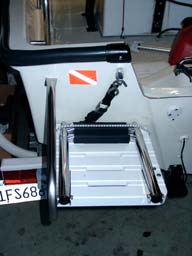 First
and foremost, you gotta be able to get on and off a dive boat. My
Montauk doesn't have the standard bow rail, which seems to have been
designed
by a lawyer to keep drunken fishermen for falling overboard. I
WANT
to fall overboard. Removing the bow rail makes it easy to do a
back
roll off the bow, but you have to remember to straighten your legs at
the
knees or you'll bang your calves on the gunwale. You can get away
with that on an inflatable and just bounce your calves off the tubes,
but
on a hard gunwale, it HURTS.
First
and foremost, you gotta be able to get on and off a dive boat. My
Montauk doesn't have the standard bow rail, which seems to have been
designed
by a lawyer to keep drunken fishermen for falling overboard. I
WANT
to fall overboard. Removing the bow rail makes it easy to do a
back
roll off the bow, but you have to remember to straighten your legs at
the
knees or you'll bang your calves on the gunwale. You can get away
with that on an inflatable and just bounce your calves off the tubes,
but
on a hard gunwale, it HURTS.
You get back on by taking your tank off and tying it to a tag line, then just climb up a three-step ladder (Windline TDL-3X) which is mounted to the optional Boston Whaler swim step. The boat came with a one-step ladder that was next to useless. I had to be a bit careful mounting the three-step ladder to make sure that it would clear the lifting eyes on the transom as it swung up and out.
Tank Racks
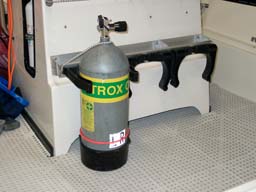 The
next thing divers need is a place to store their tanks. East
Coast Plastics
makes a great system called Roll Control. It
consists
of an aluminum channel that holds big C-shaped plastic clips that hold
the tanks. The clips are adjustable for various tank diameters
and
fold down when not in use. Be sure to check various tank heights
-- I ALMOST mounted my channel too high to hold Admiral Linda's HP
80s.
I ended up mounting the center line of the channel 14.5 inches above
the
deck. If I had to do it over, I'd mount it three quarters of an
inch
higher, which would just hold an HP 80. And I think I'd mount a
second channel two or three inches higher to handle BCs who tank bands
are in just the wrong place.
The
next thing divers need is a place to store their tanks. East
Coast Plastics
makes a great system called Roll Control. It
consists
of an aluminum channel that holds big C-shaped plastic clips that hold
the tanks. The clips are adjustable for various tank diameters
and
fold down when not in use. Be sure to check various tank heights
-- I ALMOST mounted my channel too high to hold Admiral Linda's HP
80s.
I ended up mounting the center line of the channel 14.5 inches above
the
deck. If I had to do it over, I'd mount it three quarters of an
inch
higher, which would just hold an HP 80. And I think I'd mount a
second channel two or three inches higher to handle BCs who tank bands
are in just the wrong place. 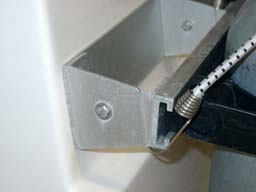 The
channel on the front of the console holds three tanks and is mounted
using
fours pairs of pieces of aluminum angle bracket, one piece bolted to
the
console, one to the console. There's a piece of 3" wide flat
aluminum
on the face of the console and a matching piece on the back which
functions
as a big washer to spread the load on the fiberglass. The
aluminum
stock is all standard hardware store stuff, cut, drilled, and sanded
smooth.
The
channel on the front of the console holds three tanks and is mounted
using
fours pairs of pieces of aluminum angle bracket, one piece bolted to
the
console, one to the console. There's a piece of 3" wide flat
aluminum
on the face of the console and a matching piece on the back which
functions
as a big washer to spread the load on the fiberglass. The
aluminum
stock is all standard hardware store stuff, cut, drilled, and sanded
smooth.
Note that there's a bungee cord securing the tank. This is only necessary in rough conditions.
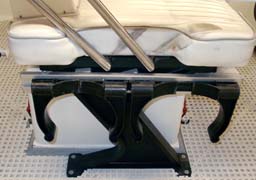 There's
more channel on either side of the bench seat, each holding two tanks.
There's
more channel on either side of the bench seat, each holding two tanks.
The Roll Control system has other components besides tank clips: cup holders, rod holders, cleats, a universal gizmo made to bolt to anything, and a short plastic channel that they claim can be glued to the tubes on an inflatable. I've used one of those to fabricate a holder from an emergency oxygen tank. I'll post some pictures by and by when I get a chance to borrow a digital camera and shoot some.
Dive Flag
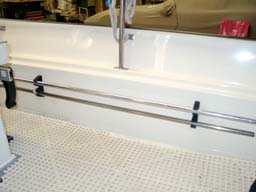 I've
been through four generations of "how to fly the dive flag". The
first generation was to attach burgee clips to the Boston Whaler anchor
light. This worked OK, but the flag wasn't very high off the
water,
and threading the power cord for the anchor light was a pain each time
I put the dive flag up.
I've
been through four generations of "how to fly the dive flag". The
first generation was to attach burgee clips to the Boston Whaler anchor
light. This worked OK, but the flag wasn't very high off the
water,
and threading the power cord for the anchor light was a pain each time
I put the dive flag up.
The second generation was a six foot section of 3/4" aluminum tubing in the anchor light brackets. This got the flag higher and eliminated the cord hassle, but still wasn't has high as I wanted it, and was mutually exclusive with an anchor light on a night dive.
The third generation was plastic burgee clips on the VHF antenna. I'd tried this on my first antenna, but its diameter was too small. The new Galaxy was a bit bigger and the 3/8" burgee clips fit perfectly.
But it was a pain to fold down the antenna to attach the flag. So for the fourth generation, I've ended up with a rail mount flag holder on to top of the console.
Fin Stowage
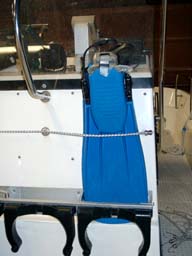 Fin
stowage is often a problem. The big floppy things lay on the deck
and everyone, especially me, trips over them. I strung a piece of
bungee cord through three stainless eye bolts on the front of the
console
to hold fins. Their tips tuck behind the tank rack channel.
If I had it to do over again, I'd mount the two center channel brackets
about an inch closer to the center line to allow for wider fins.
Fin
stowage is often a problem. The big floppy things lay on the deck
and everyone, especially me, trips over them. I strung a piece of
bungee cord through three stainless eye bolts on the front of the
console
to hold fins. Their tips tuck behind the tank rack channel.
If I had it to do over again, I'd mount the two center channel brackets
about an inch closer to the center line to allow for wider fins.
Masks, dive computers, and compasses are stowed in the fin foot pockets.
Camera Storage
Admiral Linda and I are underwater photographers by avocation. Cameras are stowed in Rubbermaid tubs with a piece of two-inch closed cell foam beneath to give them a soft ride and absorb motor vibration.Decks
I covered the decks with DriDek, a "rubber" mat that allows water to flow under it. It cushions dropped tanks, and is more comfortable to stand on (except in bare feet), and any sand gets sloshed back to the bilge without being ground into the deck. It's not cheap ($4.25 / square foot at West Marine, but it also comes in 3'x3' sections which you can get from veterinary supply places. It does come in colors (they'll even color match if you want 4500 square feet), but I thought the white looked best on a whaler.Miscellaneous
After that, most things are simple: some tag lines to clip BCs and cameras to. The lines for the BCs are nylon, the ones for the cameras are bungee cord and long enough that there's no way a diver on the surface can kick the camera.Electronics
The general layout is that navigation equipment goes right in front of the helm, the radio off to the side. The logic is that I look at the nav gear a lot more than the radio. If I had it do again, I'd leave a little more space between the depthfinder and the GPS for the compass. I'd planned on mounting the compass between the GPS and radio, but the speaker magnet in radio made the compass wildly inaccurate.Console-Mounted VHF Radio
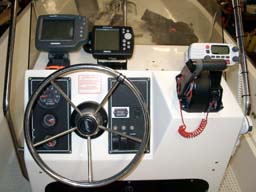 Standard
Horizon Spectrum, which is serious waterproof: submersible to 3' for 30
minutes. Not as good as my Nikonos underwater cameras, but a
bunch
better than splashproof.
Standard
Horizon Spectrum, which is serious waterproof: submersible to 3' for 30
minutes. Not as good as my Nikonos underwater cameras, but a
bunch
better than splashproof.
I strongly recommend a submersible radio on an open boat like a whaler. I used to have an Apelco 5200 (now sold as Raytheon 52). I wasn't completely happy with it. I was replaced once on warrantee because of "significant salt water intrusion". They claim it's waterproof, but it's really only splashproof.
For an antenna, I've currently got an 8' Shakespeare Galaxy 5225-XT mounted on a stainless ratchet mount on the inside aft end of the starboard rail. I used to have an 8' Shakespeare 5206-C, and replaced it with the Galaxy. The downside of the 5206-C is that it only has a 15' coax cable, which isn't quite long enough to reach the radio, necessitating a (corrosion-prone) splice. The 5225-XT has a 20' coax (and it is low-loss RG-8X instead of the cheaper RG-58).
Hand-Held VHF
Standard Horizon HX470S. I bought it as a backup while the Apelco was off being replaced. Mostly I find it handy for listening to the dive boat chatter while I'm driving down to Monterey. It's also submersible.GPS and DGPS
Currently a Garmin GPSMAP 162 with WAAS (Wide Area Augmentation System) which give and accuracy of 3-9 feet which is real handy for finding my way back to dive sites, though how necessary that is now that SA has been turned off is unclear.Depthfinder
Humminbird Wide Paramount 3D. This has six SONAR beams and draws a picture of what's under the boat. Yes, it's a toy, but it's a fun toy. It does help find some of the smaller pinnacles I like to dive.The sonar transducer is mounted eight inches to port of centerline, the speed and temperature transducer a little closer to center line?? on the starboard side.
Compass
Ritchie Explorer S-53 Surface Mount. It's mounted behind the GPS and depthfinder. I'm 6' 5" and have no trouble seeing it over the other two units. And if I'm suddenly dependent on the compass, it's because the GPS is dead, and I can swing it forward and out of the way anyway.If you operate at night, you want a black compass. I admit a white one would look better.
Voltage Regulation
In addition to the normal voltage regulator on the engine, the GPS and depthfinder are wired to a Humminbird SureVolt. This yellow box inputs anything from 6 to 24 volts, and outputs 13.2 volts. This keeps the electronics from shutting down when starting the motor. I'd wire the VHF to it too, but the SureVolt only puts out 1.25 amps, and the VHF needs 6 amps.Hour Meter
An hour meter on a boat is like the odometer on a car -- tells you when it's time for periodic maintenance.12 volt Socket
A Marinco 12 volt socket ("cigarette lighter", but no smoking on my boat) provides 12 volt power for all sorts of things. The factory wires it to the accessory switch, but I moved it to between the accessory circuit breaker and the accessory switch so that it's always hot.Safety Equipment
- Four Type 2 PFDs, and I have a couple more when we go the lake and there might be more folks on board.
- Throwable PFD. I used to think these were silly till I handed it to a diver who was having trouble staying afloat.
- Flares, whistle, horn.
- VHF radios.
- Cell phone in a dry box.
- 150' polypropylene current line.
- First aid kit.
-
DAN
O2 kit. I already had a couple medical oxygen E tanks, so I
ordered the DAN regulator only, and then put it in a Pelican two size
smaller (no sense wasting space).
Power
90 HP 1997 Evinrude carbureted two-stroke. Top speed is about 36 knots (DGPS) with just me on board and the bow trimmed up a little more than I would like. It's got a three blade 14x17 OMC aluminum prop and turns 5500 RPM at top speed. I suspect it would go a little faster with a stainless steel prop.Little Stuff only a Whaler Owner Would Care About
Prop and Performance
 OMC
Aluminum 14" x 17". It will do 35.7 knots (about 41 MPH) at 5200
RPM on the GPS on flat water, with just me and a half tank of gas on
board
and the nose trimmed up a bit more than I like. It would probably
go a bit faster with a different prop. The picture shows my 36
knot
hair do after the five mile test run at Lake Don Pedro one calm
September
evening.
OMC
Aluminum 14" x 17". It will do 35.7 knots (about 41 MPH) at 5200
RPM on the GPS on flat water, with just me and a half tank of gas on
board
and the nose trimmed up a bit more than I like. It would probably
go a bit faster with a different prop. The picture shows my 36
knot
hair do after the five mile test run at Lake Don Pedro one calm
September
evening.
Bow Locker Bumper
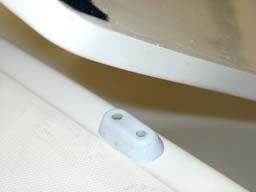 Every
time somebody (except me, and sometimes me) opened the bow locker, they
would drop the door onto the gunwale. I 'm amazed it didn't
damage
the fiberglass. I found some nice white rubber baby buggy bumpers
in the garage door section of the local hardware store. I
installed
one on top of the gunwale and now the door just bounces.
Every
time somebody (except me, and sometimes me) opened the bow locker, they
would drop the door onto the gunwale. I 'm amazed it didn't
damage
the fiberglass. I found some nice white rubber baby buggy bumpers
in the garage door section of the local hardware store. I
installed
one on top of the gunwale and now the door just bounces.
Bow Locker Latch
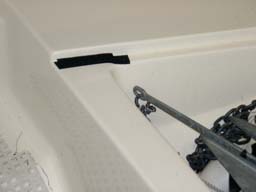 The
Montauk doesn't come with a bow locker latch. Every time you go
over
a big swell, the bow locker comes open a couple of inches and slams
back
down with a big BANG! I tried a couple of things, and eventually
settle on Velcro. Some hook Velcro on the boat, some loop Velcro
on the hatch, and some hook back to back with loop in between made a
fine
latch, except the half-life of the adhesive was about a month. At
http://www.fastech-velcro.com/twosides.html I discovered that
StickyBack
Velcro is available with several adhesives. The interesting ones were:
The
Montauk doesn't come with a bow locker latch. Every time you go
over
a big swell, the bow locker comes open a couple of inches and slams
back
down with a big BANG! I tried a couple of things, and eventually
settle on Velcro. Some hook Velcro on the boat, some loop Velcro
on the hatch, and some hook back to back with loop in between made a
fine
latch, except the half-life of the adhesive was about a month. At
http://www.fastech-velcro.com/twosides.html I discovered that
StickyBack
Velcro is available with several adhesives. The interesting ones were:
0172 - standard acrylic adhesive - red logos
0114 - better olefin adhesive - blue logos
0174 - best adhesive - also red logos
I had been using the 0172. I ordered some 0174 from them, and it works great. I was changing out the 0172 after one or two wet days. The 0174 lasted about six months, and it was the hook and loop was that got tired, not the adhesive.
The downside is that you have to order 25 yards of each, which ran about $75. But now I have enough Velcro to last forever. And a nice piece of hardware to latch it would have been close to that much.
The part numbers are 187573 (loop, 1", black) and 187574 (hook, 1", black).
I was in Staples (the office supply folks) the other day, and they had small blister packs of what they claimed was waterproof adhesive Velcro. It may be the same stuff, but in white.
Anchor Rode
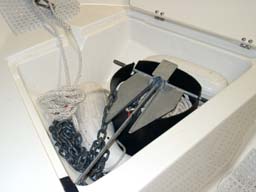 I
carry 250 feet of 3/8" nylon line and a 13' stainless chain. This is
adequate
for the sort of diving I do in Monterey where I rarely anchor in more
than
100'. The anchor is a five pound Danforth Hi-Tensile (model 5H) with the
round rod part trimmed to 15" to help things fit in the locker. I
put Ancor hot melt glue lined heat shrink on the ends of the round rod
part to keep it from chewing up the gelcoat inside the locker.
I
carry 250 feet of 3/8" nylon line and a 13' stainless chain. This is
adequate
for the sort of diving I do in Monterey where I rarely anchor in more
than
100'. The anchor is a five pound Danforth Hi-Tensile (model 5H) with the
round rod part trimmed to 15" to help things fit in the locker. I
put Ancor hot melt glue lined heat shrink on the ends of the round rod
part to keep it from chewing up the gelcoat inside the locker.
Just
tossing the rode in the bow locker wastes a lot of space
and is
tangle-prone. Stowing the line in a round bucket makes for plenty
of space for a couple of fenders and the 150' yellow current line (for
the diver to pull themself back to the boat in current). And it
doesn't tangle.
The bucket is notched so a Danforth anchor can be stowed on top of it. This makes a lot more room in the locker for stuff like fenders and current lines. A Dremel tool with a rotary cutting blade works really well for cutting the bucket, though it does tend to make a lot of plastic sawdust.
The buckets really aren't made to have an anchor bouncing
around on top of them, so they have to be replaced every couple of
years (note: I get on the water about 60-70 days a year). For the
first couple of buckets, I cut down a five gallon pickle
barrel so it just fit in
the locker and led the bitter end of the rode through a hole in the
bottom
of the bucket. This worked fine, but eventually they split out
below the rods on the anchor. The third time I used a 3.5 gallon
bucket that only had to be cut down a little and has a reinforcing
ridge
just below the rods. I suggest using a black
barrel or bucket (instead of white) because the white doesn't hold up
well in the
sun, but I couldn't find the 3.5 gallon bucket in black. I've
since found McMaster-Carr p/n 3995T419, which does come in black, and may be somewhat more heavy-duty, and will probably use it the next time around.
Note that the bow line is red and the anchor line is
white. It's a lot easier to tell your buddy "grab the red bow
line" than try to explain which white line is which.
Oil Line Routing
The factory mounts the two-stroke oil tank in the console, which is fine, but they run the oil line several inches away from the tank before they lead it through the floor of the console. I rerouted it close to the tank, which freed up precious console floor space. Console space is scarce, and sometimes I'm tempted to get a four-stroke just to get rid of the oil tank.Battery Cable Routing
The factory mounts the battery in a big hole in the floor of the console (so all that weight is on the deck), and the same guy drilled the holes for its cables. I notched out the sides of the big hole to make more room.Control Cable Routing
The factory routes the control cables and some wiring through a 6"x3" boot. I found I could slide the boot three inches aft, tucking it along side the battery. That combined with the battery cable and oil line changes, allowed me to get the next size larger Pelican case into that space. It was a lot of work, but worth it.Fenders
West Marine has some nifty Taylor fenders that look like penguins that work great on low freeboard boats like the Montauk. You attach them to the boat with the penguin's beaks up over the gunwale.Lifting Sling
To launch at Stillwater Cove in Carmel Bay, you gotta have your own sling. My three-point sling has a bow cable 133.5" eye-to-eye, and stern cables 85" eye-to-eye. The carabiners add 3" to each. The middle is a big egg shaped steel ring. The cables are about 1/4" stainless covered with plastic. The dealer made it up -- NOT CHEAP, but well made. Make sure that whoever swedges the cables knows what they are doing. I've seen the egg-shaped rings at mcmaster.com or granger.com since, and I think they'll do the cables too.Trailer
There are lots of decent brands of trailers. Mine is a Shorland'r.Do not put a Whaler on a full roller bunk trailer. The localized stress of the rollers will delaminate the fiberglass from the foam. Either use a trailer with keel rollers and carpeted bunks on the side, or all carpeted bunks. Mine has all carpeted bunks. I discovered that spraying the bunks with silicone makes it a lot easier to get the boat on and off.
My trailer came with a nice long tongue. This is great for launching because it keeps the truck away from the salt water, but it meant the rig wouldn't fit in my garage. I had Eyers Hitch Center in San Jose hitch modify the trailer to have a removable tongue and now it fits in the garage. I had Acme Galvanizing in Oakland hot dip galvanize the new tongue (the trailer was galvanized to start with - ALL boat trailers, fresh water and salt, should be galvanized). The removable tongue can also be used to extend the tongue another 18" which is handy for ramps like Pt. Lobos.
A note for you inflatable divers: one of the nicest things about my trailer is that the boat sits down between the tires instead of on top of them. This also helps keep the truck away from salt water. Most inflatables situate the boat above the tires, about a foot higher than it needs to be.
Between the long tongue, extensible tongue (which I only use at Pt. Lobos), and the low boat position, I only get the truck tires wet on the very roughest days.
The trailer is galvanized. All boat trailers should be
galvanized.
Tow Vehicle
2001 Nissan Pathfinder four-door. This is my third Pathfinder. My first was a 1987 two-door, one of the first, and I put 130,000 miles on it, and the following things went wrong: an electric window winder died, and the gauge half of the oil pressure sender started putting out wonky readings (the idiot light half was fine). That's it, other than normal maintenance. My second Pathfinder was a 1995 four-door, and I put 130,000 miles on that one too. I think it burned out a couple of lightbulbs. With reliability like that, would you buy something different? The stick shift models have a 3500 pound towing capacity, which is fine for my rig which weighs about 2000 pounds. The automatics have a 5000 pound towing capacity.I'll confess that with the '95 Pathfinder I had to down shift to third for two hills between home and Monterey. With new 250 HP 3.5L DOHC V6 in the '01, I do the first one comfortably in fifth gear, and just barely to fourth for the last steep bit of the second one.
http://
Last updated .